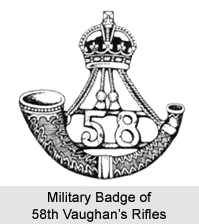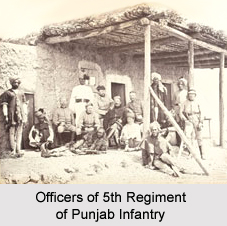 The 5th Regiment of Punjab Infantry or the 5th Punjab Infantry was a former infantry unit of the British Indian Army. It was also known as 58th Vaughan`s Rifles (Frontier Force) and was established in the year 1849. The unit was renamed as the 58th Vaughan`s Rifles (Frontier Force) in the year 1903; and later in 1922, it was designated as 5th Battalion 13th Frontier Force Rifles in 1922.
The 5th Regiment of Punjab Infantry or the 5th Punjab Infantry was a former infantry unit of the British Indian Army. It was also known as 58th Vaughan`s Rifles (Frontier Force) and was established in the year 1849. The unit was renamed as the 58th Vaughan`s Rifles (Frontier Force) in the year 1903; and later in 1922, it was designated as 5th Battalion 13th Frontier Force Rifles in 1922.
History of 5th Regiment of Punjab Infantry
The 5th Regiment of Punjab Infantry was formed by Captain J E Gastrell on 18 May 1849 at Leiah and was included as a part of the Transfrontier Brigade. The brigade was further developed in 1851 and was renamed as the Punjab Irregular Force, which was later known as the The Piffers or the Punjab Frontier Force. It included 11 regiments of infantry, 5 regiments of cavalry and 5 batteries of artillery, besides the Corps of Guides. Their primary objective was to sustain order on the Punjab Frontier.
During the Indian Sepoy Mutiny in 1857, the 5th Punjab Infantry participated in various frontier operations and was later stationed in Nepal and Oudh. The troops actively participated in the Battle of Peiwar Kotal during the Second Afghan War from the year 1878 to 1880. It was also involved in the defence of Sherpur Cantonment at Kabul and was later engaged in the Tirah Campaign. After the reforms in the British Indian Army in 1903 administered by Lord Kitchener, the army unit was re-designated as the 58th Vaughan`s Rifles (Frontier Force). The class composition of the regiment in the year 1914 included one company of Dogras, one company of Punjabi Muslims, three companies of Pathans and three companies of Sikhs. The troops served on the Western Front from 1914 to 1915 during the First World War. The regiment took part in various British conflicts and conquests, such as the Battle of La Bassee, the Battle of Givenchy, the Battle of Neuve Chapelle, the Battle of Aubers Ridge and the Battle of Loos.
 The 5th Punjab Infantry was sent to Egypt in 1915 and was later stationed in Palestine in the year 1917. The army unit fought in the Battle of Nebi Samwil, the Third Battle of Gaza and the Capture of Jerusalem. It also took part in the Battle of Megiddo in 1918. The unit also provided significant military service during the First World War. After the end of the Great War, it was merged with the 55th Punjabi Rifles, 57th Punjabi Rifles, 59th Punjabi Rifles, and the two battalions of 56th Punjabi Rifles (Frontier Force) in order to develop the 13th Frontier Force Rifles in the year 1922. It became the 5th Battlaion of the 13th Frontier Force Rifles regiment. The 5th Regiment of Punjab Infantry later served in Italy, North Africa, Lebanon, Iran and Iraq.
The 5th Punjab Infantry was sent to Egypt in 1915 and was later stationed in Palestine in the year 1917. The army unit fought in the Battle of Nebi Samwil, the Third Battle of Gaza and the Capture of Jerusalem. It also took part in the Battle of Megiddo in 1918. The unit also provided significant military service during the First World War. After the end of the Great War, it was merged with the 55th Punjabi Rifles, 57th Punjabi Rifles, 59th Punjabi Rifles, and the two battalions of 56th Punjabi Rifles (Frontier Force) in order to develop the 13th Frontier Force Rifles in the year 1922. It became the 5th Battlaion of the 13th Frontier Force Rifles regiment. The 5th Regiment of Punjab Infantry later served in Italy, North Africa, Lebanon, Iran and Iraq.
Designations of 5th Regiment of Punjab Infantry
The military regiment held several titles during it service under the British Indian Army. These are mentioned below -
* 5th Regiment of Punjab Infantry - 1849
* 5th Regiment of Infantry, Punjab Irregular Force - 1851
* 5th Regiment of Infantry, Punjab Frontier Force - 1865
* 5th Punjab Infantry - 1901
* 58th Vaughan`s Rifles (Frontier Force) - 1903
* 5th Battalion (Vaughan`s) 13th Frontier Force Rifles - 1922
* 5th Battalion (Vaughan`s) The Frontier Force Rifles - 1945



















